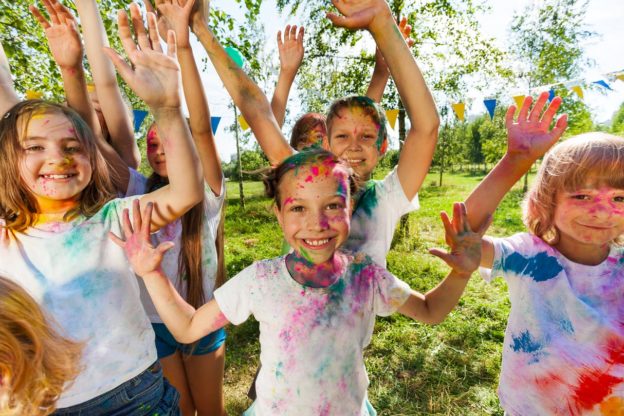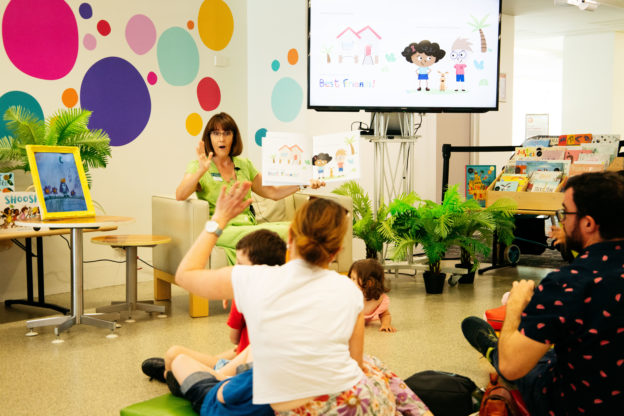It’s easy to take our environment for granted here in Australia. We’re blessed with natural spaces, clean water and fertile lands. But human impacts on the land, water and air are all changing the environment – and we’re feeling the impacts with climate change, endangered animals and natural disasters.
Some of the most basic things we need to survive and thrive can only exist if we do our best to maintain healthy and sustainable living practices. Clean air, water, food, and safe outdoor spaces are the foundations of a healthy society.
For children and young people, the right to a clean environment is essential in nurturing their growth and development. Clean air, safe and secure surroundings, and outlets for physical activity play a role in how they interact with and understand the world around them.
For many children, this right is still out of reach.
Many young children are still exposed to environmental pollutants from sources such as unsafe drinking water, air pollution or chemicals, as well as limited or no access to spaces for outdoor physical activity and exploration. This leaves them at a much higher risk of disease and developmental delays that can have long lasting effects on their psychological, physical and emotional potential.
So, how can we create a clean environment that keeps children safe and allows them to flourish?
The right to a clean environment
The United Nations Convention on the Rights of the Child states in Article 24:
Children have the right to good quality health care, clean water, nutritious food and a clean environment so that they will stay healthy.
So what does this mean exactly?
Governments must do their best to provide the best standard of living for every child. Starting from a healthy physical environment, right through to essential health care systems that can treat each child if they become ill.
It recognises that in order to reduce child mortality rates and help children reach their full potential, states, educators, families, and the wider community must all work together to promote healthy living, and encourage a deeper understanding of how a clean environment can help achieve this.
Impact of a clean environment on a child’s development
There’s no doubt that a clean physical environment can significantly influence early childhood development.
Clean and safe indoor and outdoor environments optimise development opportunities. By reducing exposure to pollutants and contaminants, children have more opportunities to engage socially, participate in physical activity, and interact with their surrounding environments on a daily basis.
Encouraging more time outside amongst a clean environment is key to lowering obesity in young children and adolescents, while also enabling greater development of motor, social, emotional and cognitive skills.
When considering clean and safe environment for children, it’s important to think about the following:
Urban environments: How we choose to plan our urban environments is vital in creating a cleaner physical space for children to enjoy. This includes clear zoning between commercial and residential areas, smarter planning of roads to reduce traffic, efficient public transport systems and more areas designated for green spaces.
Nature and open public spaces: Green spaces have a huge positive impact on the physical and mental wellbeing of children. Playgrounds, school grounds, council facilities all support childhood development, and provide extensive opportunities for play, adventure and exploration. This becomes even more important when considering children who may not have access to a backyard.
Climate and the physical environment: Extreme weather events and warmer climates have been linked with poor developmental outcomes. Hotter homes and classrooms, less tree cover in urban areas, and greater dependence on carers to stay hydrated are all new challenges that impact each child’s ability to learn, play and grow.
Advancing children’s right to a healthy and sustainable environment
Creating a clean environment for children is everybody’s business. From the top of government to daily activities in the family home, here’s how we can all make a change.
Government
With considered planning, local and state governments have the capacity to plan and create clean environments that benefit children. Councils have a long lasting positive impact on children’s development by implementing the following changes:
- Promote greater interaction with the environment via walkable suburbs that rely less on motorised transport
- Shield children from environmental harm by creating space between child-relevant locations and environmental toxins (traffic, factories)
- Fund and promote better temperature control in public spaces such as schools, libraries, child care centres and recreation centres
- Include families and children in neighbourhood planning to create a greater sense of ownership of the local environment
Schools
A well-maintained and properly planned physical environment is fundamental in fostering positive learning attitudes. By ensuring a safe space to learn and socialise, children are enabled to develop fully and achieve positive academic, social and emotional outcomes.
Working together, schools and carers can develop policies that guarantee this type of environment, and ensure that all students have access to the following:
- clean drinking water
- clean and safe bathrooms
- healthy indoor air quality
- nutritious fresh foods;
- access to safe, clean, shaded green spaces for outdoor play
Community
While mandated policies from government and schools can drive large scale positive change to our environment, the needs of the community are where it all begins.
Education, engagement and collaboration among community members and organisations plays a vital role in shifting attitudes and enacting change through practical, everyday actions.
Here’s how local communities can create a cleaner environment for all children:
- Create a shared garden or green space for your neighbourhood, social group or workplace.
- Start a local recycling program and collect old phone books and other paper items.
- Organise a rubbish clean up event for local walking trails, parks, or even just the side of the road.
- Stay on top of your energy use at your school, workplace or community centre.
- Host a fundraiser with the aim of purchasing more energy efficient products and services.
How can we help children learn to take care of the environment?
When children are given some responsibility to look after themselves and their surroundings, it encourages them to engage and learn on a deeper level..
Environmental responsibility is no different. By supporting children to become environmentally responsible via fun and authentic learning experiences, they can become active participants and decision makers in the world around them.
Here are a few ways children can interact with their environment and learn to take pride in sustainability and the world around them:
- Have a discussion about what they know already, what they’d like to learn about and how they can get involved.
- Develop care and awareness for their environment with tasks that require time and attention, like watering plants.
- Environmental discovery activities can teach children to appreciate and respect their surroundings.
- Explore conservation and put it into practice each day by identifying separating waste from recycling, and starting a compost bin.
Of course, there are many more ways we can help support each child’s exploration of their environment, but these are some simple ways to get the ball rolling and foster greater care for a clean and safe environment.
Let’s make a change!
The power of the physical environment can’t be overstated, and its ability to affect children’s development is a key factor in crafting future environmental policy.
Each child has the right to a clean environment, and ensuring this right allows them to be the best person they can be – not just today, but for all future generations.
If you’d like to learn more, visit the Australian Institute of Family Studies for more information.
REFERENCES
https://www.unicef.org.au/our-work/information-for-children/un-convention-on-the-rights-of-the-child
https://www.unicef.org/media/55261/file/Global_Annual_Results_Report_2018_Goal_Area_4.pdf.pdf
https://aifs.gov.au/cfca/2021/06/18/creating-environments-support-young-childrens-development
https://safesupportivelearning.ed.gov/topic-research/environment/physical-environment
https://natureplayqld.org.au/wp-content/uploads/2021/07/sustainability-11-04212-v2.pdf
https://www.qld.gov.au/__data/assets/pdf_file/0022/64237/h-cap-qld.pdf













